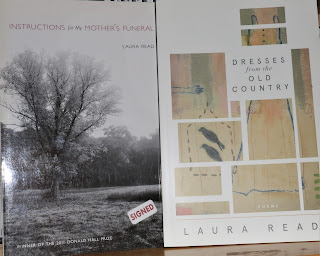Every year, for some reason, I expect to buy fewer books than I had in the previous year. I assume that I will content myself with the books that I already own. During 2021, I added thirty-six more books to my account at LibraryThing. My total now is at 1,064. It’s getting to the point where I need to make a decision about which books I want to keep. I plan on giving some away the next time one of the local libraries starts asking for donations.
I discovered Pamela Stewart’s chapbook Just Visiting, which
was published in England in 2014, quite by accident and ordered the chapbook
directly from the publisher, who would have sent me a free copy if I had not
insisted on sending him the cash. My relationship with Pamela Stewart’s work
extends as far back as the 1970s, beginning with her chapbook The Hawley Road
Marsh Marigolds. She has promised to put together a selected poems, but I haven’t
heard anything about the book as of yet. The poems in Just Visiting are often
more personal than some of her other poems. I prefer those poems in which she
writes about what she observes and what she has known.
Thanks to Natalie Goldberg’s Writing Down the Bones, I have
learned to overcome those doubts and negative thoughts that were keeping me
from my own writing. This book helped me so much that I wrote twenty-three new
poems in 2021 and revised several older ones.
Having discovered Bill Moody’s novels containing the character Evan Horne last year, I decided to read his thesis, Jazz Exiles, an examination of those jazz musicians who chose to live in Europe or Japan. While largely composed of interviews, the book reveals how much racism and a lack of regard for jazz as an art form contributed to jazz musicians choosing to live abroad. For fun, I also reread Moody’s Fade to Blue, the last of the Evan Horne novels.
Each year the community college where I work offers those
instructors who teach writing the opportunity to focus their assignments around
one particular book. The book selected in 2021 was Sarah Smarsh’s Heartland: A
Memoir of Working Hard and Being Broke in the Richest Country on Earth. Born
and raised in south central Kansas, Smarsh describes her efforts at getting
away from the poverty that the women in her family have known, often as a
result of marrying badly and having babies at a young age. As a reader, I
wondered why contraceptives weren’t stressed among her family members. I don’t
remember her mentioning what influence religion might have played in her family’s
reluctance to practice birth control. Some contraceptives, of course, cost money,
and without health insurance, it is difficult to engage in family planning.
Two other memoirs that I read in 2021 were Gretel Ehrlich’s
Unsolaced and Judy Blunt’s Breaking Clean. I learned of Blunt’s book from
reading Mary Clearman Blew. Blunt’s book, I thought, ended too soon because I
wanted to learn of her transformation once she left eastern Montana and arrived
in Missoula. I started reading Gretel Ehrlich when I was in graduate school,
and I shared one of her essays about Wyoming (long before I ever visited the
place) with my students when I was teaching freshman English. It was Ehrlich’s
language, particularly her descriptions, that appealed to me. Unsolaced is a
book of exploration, memory, loss, renewal, and love, and it is set in places
like California, Zimbabwe, Greenland, Kosovo, and Wyoming. It serves as a kind
of “bookend to The Solace of Open Spaces,” Ehrlich says.
Having previously read Elizabeth Kolbert’s Field Notes from a Catastrophe:
Man, Nature, and Climate Change and The Sixth Extinction, I read her recent Under a
White Sky: The Nature of the Future, a book that examines the ways in which
science has been used to manipulate nature. As a reader, I found myself wanting
the book to contain more conclusions. It seemed as if each chapter was meant to
stand alone when I wanted a narrative that connects the chapters and that draws
conclusions at the end of the book.
Once again, I have every intention of buying fewer books during
the current year. I can try to step inside library sales and bookstores like Half
Price Books and Barnes and Noble less often, but I cannot guarantee that I won’t
be drawn to a book of poems by someone whose work I admire or whose work I want
to discover.


